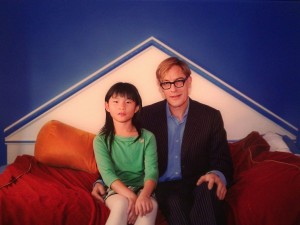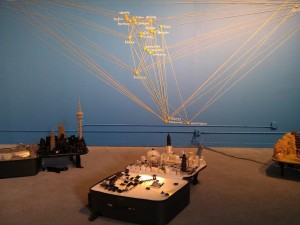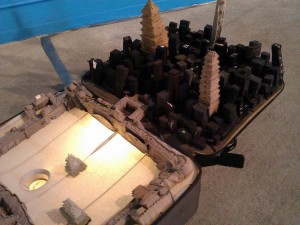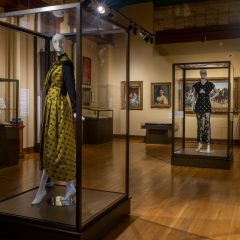Don’t let the modesty of Drexel’s current exhibition space (in a low building with a basic large space plus a couple of side rooms) fool you. Right now a museum-quality exhibit shines there.
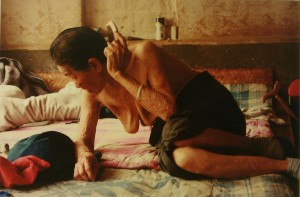
Half the Sky is the first survey-scaled show in America of contemporary art by Chinese women artists. The more than 20 artists range from women whose work is well-known in the west, like Cao Fei and Zhang O, to women whose main reputation is in China, including Tao Aimin, whose Sunset series is displayed in a room by itself–you have to make a choice to see or not to see.
Tao’s unrelenting eye has produced 50 c-prints and video, merciless shots of extremely elderly people caring for themselves. I don’t know how disturbing this work would be for a Chinese audience, but I know, in this country, we insulate ourselves from the facts of old age and death by concentrating the aged in their own communities and centers. So to see something so ordinary as wrinkled skin is disturbing. To see an old woman caring for her bound feet is disturbing. And to see in a video an old woman pulling on her drawers, her crotch completely exposed as she struggles on a large bed, is etched in my mind.

I found myself wondering if the subjects of this work were in the least embarrassed. I thought for a moment or two, perhaps they are too old to care. Then I remembered how my sweet mother-in-law kept a semblance of vanity to the very end. I wondered how China treated its elderly. Do they stay with family, in their community? Or, do the Chines shuffle the elderly off to granny camps, as we do here? What struck me, however, is the subjects’ apparent autonomy. The woman pulling on her underpants, after all, is in charge of her own dressing, even with her limited range of motion. There’s a suggestion of cultural patience with the time involved–and ancient culture with patience for the long view. In our country an aide would come in and, whoosh, granny is dressed in a trice–infantalized and left with nothing to do but sit.
I also wondered if the subjects, who are so very old, even knew their pictures were being taken. What are the rules of this other society? Do people have some sort of idea, like ours, that our images are to some degree our own property. That idea is rapidly changing here, with all of us snapping and YouTubing each other without any request for permission or signature on a waiver.
These photos and videos are a mix of honest and unkind. And herein lies two ugly truths–that of aging and that of youth! The young eye exposes its own horror at what it sees, and in spite of itself, exposes some unexpected beauty.
This is the sort of conversation I held with myself over and over as I walked through this exhibit.
Zhang O, Dad and I
The new world order of East meets West is embedded in the photo by Zhang O, Daddy and I. The loopy almost sit-com ambiance with the conflicting racial information creates for uncomfortable ambiguity. Just which country is this? And who is the man? the girl? Is she adopted? a victim?
Yin Xiuzhen, Portable City-New York, 2010, 80 x 86 x 28 (suitcase closed), Portable City-Shuzhou, 2010, 80x86x28 (suitcase closed) Portable City, DunHuang, 2010, , 80x86x28 (suitcase closed)
The industrialization of China–and its relationship to the industrialized world–gets powerful treatment from Yin Xiuzhen. Beneath a wall connecting the cities of the world with thread and buttons, Yin lays out three open suitcases, each holding sewn and stuffed contemporary cityscape sculptures. The suitcases capture the notion of urbanization and populations on the move–or at least goods and ideas on the move. Yin uses recycled fabrics in her work.
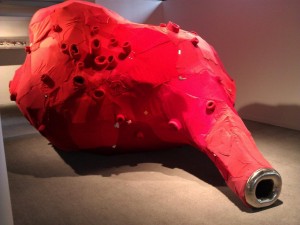
Yin’s giant red Engine, is not quite as big as the Franklin Institute heart, but its fabulous red uneven skin suggests imperfection, as contrasted with the silver ring at the artery’s cross section, which announces the industrialization of the human body. I think it looks like a womb with an industrial egress. These pieces confront global issues, maintain humor, and incorporate Eastern and Western art traditions and cultural tendencies!
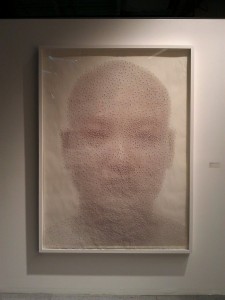
Lintian Miao’s thread- or string-wrapped bike almost passes for hipster chic in this city, where the heroic bicycle held together with string looks just right. Her giant knot-studded self-portrait made me think of pixels redefined in terms of warps and woofs–and also the Modernist grid reimagined. (I wrote about the self-portrait in 2004 here).
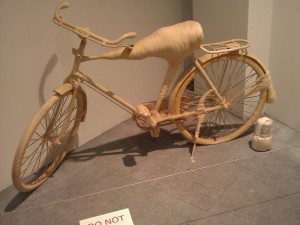
Women’s roles amidst all this upheaval shows up in Lin JingJing’s video of barely opened live roses being stitched closed (image near top of post). Oh horrors. A nice mix of sweet and awful that stretches beyond the obvious symbolism to embrace ideas about the lives of factory workers losing their youth in hard labor.
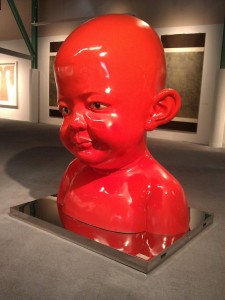
Old ink techniques get a reimagining in He Weina’s whimsical but dark drawings of young women on the edge of a nervous breakdown. A giant baby sculpture by Jiang Jie confronts the power of babies in political terms, quoting nationalistic public sculptures of Chairman Mao. And a sculpture of two naked women, by Xiang Jing (shown near end of post), simultaneously asserts individuality and conformity in the service of the state.
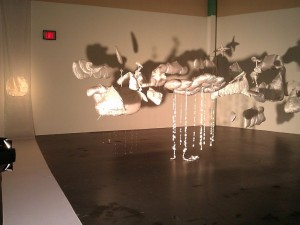
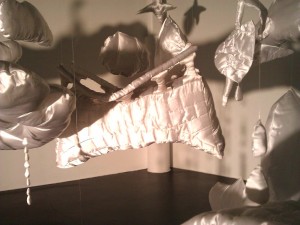
For sheer bravado, Liu Liyun’s room-size stuffed landscape deserves notice. Liu stitched, stuffed and hung in the room traditional elements like picturesque bridges and floating clouds from Chinese ink-drawing and screen landscapes. The elements are stark bone white, casting dark shadows of their power even to this day on the walls of the room. While the work is youthful, the artist still manages to express the passing of time and the loss of old China.
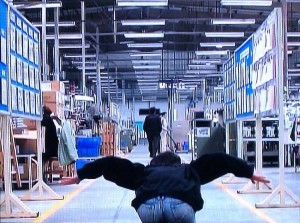
Videos in this show are an enormous presence. The international superstar Cao Fei shows some of her well-known work confronting issues of the individual in society. In Whose Utopia, people enact their dreams in a light bulb factory, and in Live in RMB City, a child avatar asks questions about reality in a Second Life milieu, confront the same issues — the individual in society. Roberta, Andrea and I have all written about Cao and Roberta even wrote briefly about the video Whose Utopia.
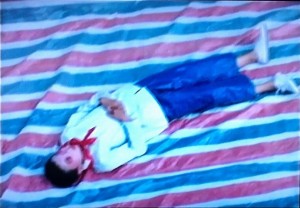
Chen Qiulin’s Color Lines video confronts the wholesale destruction of the old China as the country rebuilds itself into an industrial and political powerhouse. Filmed amid ruins and rubble, a dreamy angel spreads a striped-cloth pathway through the destruction, thereby helping a group of children, who change into crisp uniforms of synthetic materials, move through the past onto the cloth where they come to rest. The video is beautiful to watch, and full of engaging ambiguities. Cui Xiuwen shows a number of videos and photo collages, including a grainy video of women in front of what appears to be a ladies room mirror, applying makeup, washing up, changing clothes–some usual and unusual behind-the-scenes activities for going out to face the world. I do not know if these women are performers, or hookers or just ordinary users of a ladies’ room, but I felt like I was having a Nan Goldin moment in a seedy part of China.
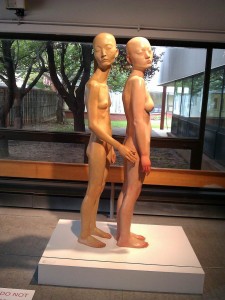
The art in this show exposes a world undergoing a huge shift in values; the Chinese shifts are seismic; our own shifts are less so. These artists feel the impact of Western art and culture. And slowly but increasingly faster, Chinese influence is making inroads on our cultural hegemony as well as our economic autonomy. All the more reason that this excellent show is not to be missed.
The show is also a statement by all involved that the work by these women is as powerful as the exciting men’s art coming out of China. It makes its case.
I will be putting up an interview with show Curator Joseph Gregory about how this show came to Drexel. Gregory is chairman of art and art history at Drexel.

The New Leonard Pearlstein Gallery (3401 Filbert St)
Friday, September 23 through Saturday, November 12th
Gallery Hours: Tuesday-Saturday, 11 a.m. – 5 p.m.
Contact: 215-895-2548 or e: gallery@drexel.edu
3401 Filbert Street (midway on the north side of the street, with a canopy overhanging the door).



